“They’re killing all the bugs!” – L
The beginning of this inquiry came after recess one day when the children were lining up, and a child was crying.
L explained that a few other children were going around stepping on all of the bugs that they found.
When we got back upstairs, we had a meeting.
“What’s happened outside that has made some of our friends upset?
“They’re killing all the bugs!” – L
“Ya, why are you guys doing that?” – B
“I don’t know” – An
“He told me to!” – E
“Because I am scared!” – A
A quick conversation about what to do if someone tells you to do something that you’re not quite sure you want to do, led to the life of bugs and why L was so upset about other people killing them.
“They have a family! and moms, and dads, and friends” – L
…do they?
Here starts our story of bugs.
Since the entire class was drawn into the problem some were having, we decided to stick with this idea until we figured out if it was just an interest or an inquiry. The difference is simple.
Quick detour: An interest is usually something temporary, something that generates a lot of buzz for a few days or weeks but then disappears. Sometimes this can be a fad or something socially popular: Pokemon, Shopkins, etc. Interests don’t usually inspire deep questions or philosophical discussion, and usually they don’t cover any conceptual foci (something that will transcend space and time).
An inquiry is something that involves concepts and action. Inquiries last. They inspire outside-of-the-box thinking, creativity, and problem solving. An inquiry usually follows a flow or a cycle, and should always include something ‘real’.
For example, an inquiry into dinosaurs includes science heavy concepts like evolution, natural selection, changes over time, etc. It can also include concepts like safety, needs vs wants… and questions like “what happened to them?”, “where did they go? and why aren’t they here anymore?” “What would happen if they were still living with us?” “How did dinosaurs evolve?” The action piece would be looking at connections to animals living now, and could lead to a study on extinct or endangered animals and the impact it has on our world.
An interest of dinosaurs will mainly deal with a lot of superficial questions like what did they eat, what did they look like, what kinds of dinosaurs are there.. but nothing deeper. Think ‘on’ vs ‘into’, ‘theme’ vs ‘concept’. We want to try to stay away from ‘themes’ and focus on a more deeper issue that students can use and apply to other areas of their lives.
We want to honour both interests and inquiries within a classroom, but we want the majority of learning to be driven by the inquiries.
Alright, back to bugs!
OH! Wait – two more clarifications: a student-initiated inquiry is easy to explain since the name says it all — it came from a student, or students, and they essentially led the rest of the class. A spontaneous inquiry means that it wasn’t planned for, and it came out of the blue, it wasn’t expected.
In my six years of teaching Kindergarten, this has happened to me two years in a row. I think it is because I have more experience now and notice when a student is initiating something that would be beneficial and relatable to everyone, and also because I understand curriculum expectations and can make links and connections a bit easier than I could a few years ago.
ALRIGHT… NOW… BUGS!
As we were figuring out the bug situation, we decided that collecting what everyone knew about bugs would be a good place to start. We had a discussion about what everyone thought they knew about bugs and where they were getting their information from, and we generated a big chart paper full of sticky notes made up of the children’s drawings and words. This was our first brainstorm. We categorized their thoughts based on similarities (we put together all the thoughts on what they eat together, where we find them, what they look like)
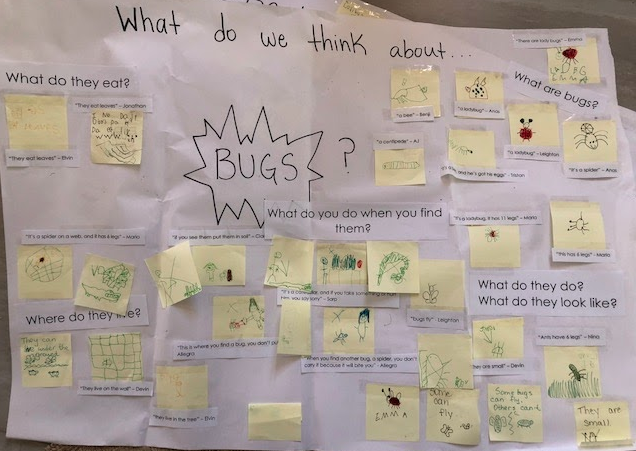
There were soooooooo many misconceptions there and that’s when I knew this would probably stick and morph into a great inquiry. Their misconceptions came from areas relating to what bugs looked like, what the difference between bugs were (like, ants, ladybugs, spiders, and butterflies), where we could find them and where they lived (some said they lived on walls because that’s where they always seemed to find bugs!), what a bugs life was like — do they have families? get married? have friends? do they play? do they talk to each other?
AND OF COURSE we had questions about poop and farting, Kindergarten 😉
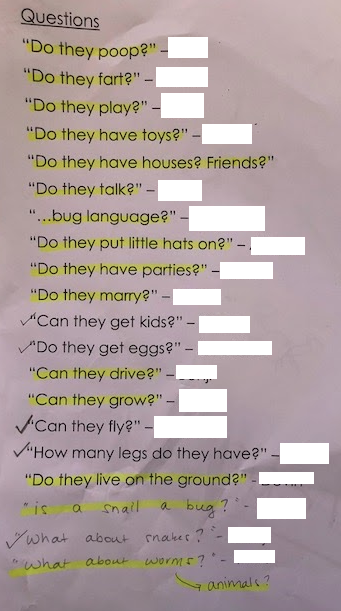
I am skipping ahead a bit.. let me back up.
All of their theories and questions were honoured and important, so after we had our discussion about what we knew. We put this up on the wall. We went to the library and took out all the books about bugs we could find. Throughout the next few days we let the children do some ‘research’ using the books. After that, we gathered again to discuss what people were finding in the books and what they were wondering about.
We documented everything.
We used this question list as a guide. Every time we read something, had a discussion, a visitor, or anything research-based that would add to our knowledge – we referred back to our list either checking off things we learned or added to the list.
Through all of our discussions, they were especially interested in how to protect them from others who wanted to kill them. So our big concept here was safety and our role in protecting nature and living things.
The big question was “How can we help bugs?”
A group wanted to create posters that we would put up so that other people knew this was a problem, so that’s what we did – we didn’t get around to actually putting these up, because a bigger issue actually came up — we couldn’t find bugs anymore!
The inquiry shifted a bit from how can we help them to how can we attract them AND keep them safe.
We realized this inquiry would focus a lot on research and the lens we used was perspective. We were going to look at this through a bugs eyes. How can we attract them to our playground? We needed to figure out what they liked, where they lived, how we could create a safe place for them, and through finding all of this out we would hit some factual information too (like the names of different bugs and what they looked like). Since there is no real expectation for this within our curriculum, we focused on science based expectations on research and finding information from different sources, and creating plans. Of course we had plenty of literacy components to this inquiry (like labeling, exploring with fiction and nonfiction and their uses, asking and responding to questions, drawing/writing for different audiences, making predictions).
The research components:
We used books from our library, YouTube videos, pictures found on Google, experts in the field of bugs, our own observations, and each other.
We ‘rescued’ many bugs we found outside and brought them in for observation. We learned a lot when bugs in our care died (not every bug likes to swim). We also rescued a bug we found in a yogurt container someone had left out and released him when he was healed and able to fly again. A parent gave us a really fantastic microscope to use along with some samples of bug parts too. We had a lot of great observation opportunities.
We were also lucky to find out that one of our high school students knew a lot about bugs! She came in and answered some of our questions (even the farting one! Did you know there’s a special name for bug farts? I DIDN’T! But now I do! I won’t tell you, but you can do some research of your own!).
We realized we can get information from so many places.
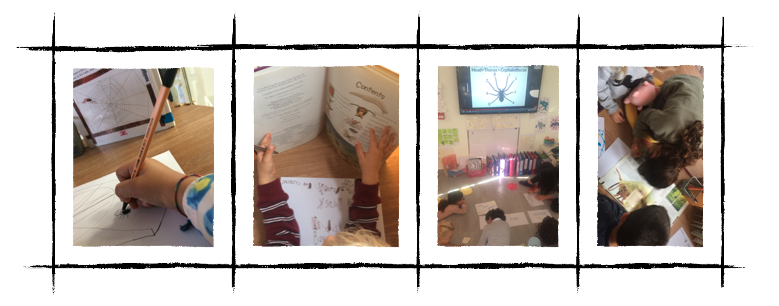
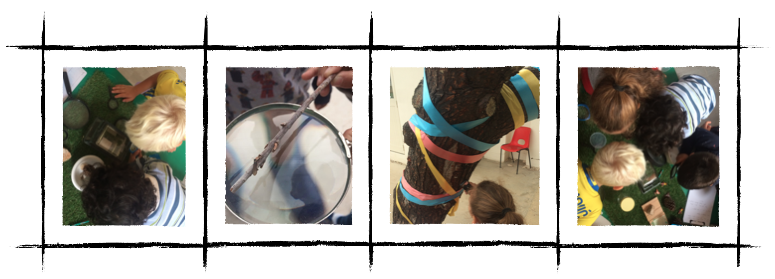 Once our research kicked off, we had a LOT of information.
Once our research kicked off, we had a LOT of information.
Do you know what an arthropod is?? I definitely didn’t.
It’s always great when I learn something new along with the children. This is something we learned when a student said “a spider is kinda like a bug but it is a spider not a bug” and also when a student drew a crab on our ‘what we think about bugs’ brainstorm. We learned they’re all under the Arthropod umbrella, and it branches out into four different categories. We learned this while watching a short YouTube clip about specifics (how many legs they have, etc).

The children wanted to create a space for bugs to come to our playground and one they could bring them too when they were found. They realized we didn’t have much of the things they liked (grass, plants, trees, dirt) and this was our first problem. Our second problem was how were we going to create something and what would it be.
I asked the children where they stay when they visit other countries, because luckily our entire class travels so drawing from personal experience would be beneficial here. They made the connection that when they go to another country they stay at a hotel or someone’s house. So they realized the bugs needed to have something like that in our playground.
We needed to create an insect hotel.
Our research continued. Everyone drew their ideas of what this could look like, what we needed to make it, and materials bugs would like so that they would want to come.

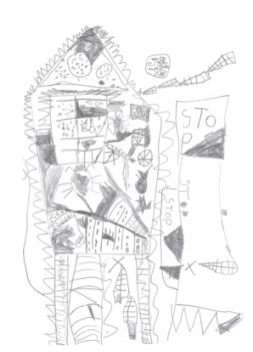


We called for help from parents with items they could donate to us, and we got a lot of response back! We got soil, old pots, turf, bottles, all kinds of recyclables.
We began creating the insect hotel using pallets and all our materials, we realized that we didn’t actually have nearly enough stuff — so we had to pause on the building.
We also didn’t start this at a great time (weather-wise).
It gets quite windy and rainy during winter, and most of our stuff blew or washed away. It was a great lesson on building though — the children realized that some materials weren’t heavy enough to stay put.
We did a LOT of reflecting about our insect hotel and what we would change next time.
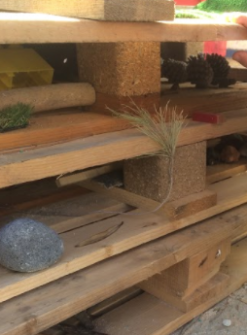
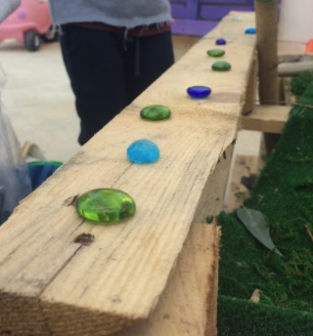
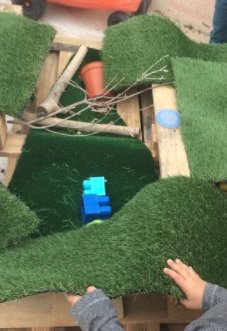
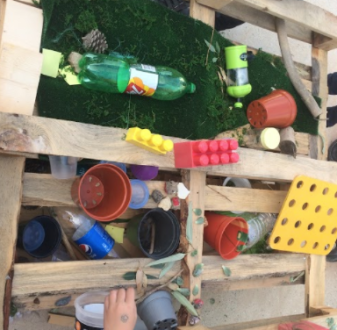
Our inquiry took a break. The holidays came and their interest in our inquiry faded.
This was okay — we collectively decided that we take a break and revisit this if needed once the weather gets better. Now that the weather is nicer, we might see the inquiry pick back up although I am not sure it will. The children still talk about bugs and are excited when they find a book in the library. They refer back to our learning often. I would love for it to kick back off again before the summer starts, so that we could create a space for bugs that will last in our playground — but if it doesn’t that’s okay too. I was very happy with how this started and where it went, and the learning that took place. This was closer to the beginning of the school year, and I feel it really helped create a bond with each other in our class, it created a wonderful community that was built on care and kindness and empathy.
The action piece to this inquiry is still very active. We are still rescuing bugs we find inside and outside, we have our bug experts who volunteered to rescue bugs in danger, and we try to take care of nature as best as we can.
If you’re starting an inquiry into bugs – I’d love to hear about it.
– – – –
Here are some things we found useful:
Sid The Science Kid – Bugs Club (pretty sure I found this on Netflix or YouTube but can’t find a good link anymore
The Magic School Bus – Ants in My Pants
http://dai.ly/x4khudd
If you use Speakaboos there’s a great interactive story about bugs — if not, YouTube has a link: https://www.youtube.com/watch?v=Wmry_E-5JLw
SciShow kids on YouTube has a lot of great links — although they talk SO FAST.. too fast for me even. So we pause a lot and I repeat what was said.
Check out your school library or a local library — we found some great information about bugs through books, and the children were able to do independent research using the pictures and labels of some.
This post had a lot of great book ideas (we only had a handful of these in our library).
https://www.notimeforflashcards.com/2013/02/19-books-about-bugs.html
Use people in your neighbourhood or school community. A lot of children are interested in bugs and already have a lot of knowledge that they’d probably be willing to share. Reach out to upper elementary or if you have a middle school or high school nearby, seek out the science department for help!